Motivation Theories: Enhancing Leadership and Employee Engagement
VerifiedAdded on 2023/06/11
|7
|1881
|294
Essay
AI Summary
This essay provides an overview of motivation theories and their significance in leadership management. It begins by defining motivation and its importance in achieving organizational goals, highlighting how it drives employee commitment and productivity. The essay then delves into various content theories, including Maslow's hierarchy of needs, McClelland's achievement motivation theory, and Herzberg's two-factor theory, explaining how each theory elucidates different aspects of human motivation in the workplace. Furthermore, it discusses process theories such as reinforcement theory, Vroom's expectancy theory, and Adams' equity theory, illustrating how these theories explain the cognitive processes underlying motivation. The essay concludes by emphasizing the role of motivation in enhancing employee engagement and performance, suggesting that organizations can leverage these theories to create a motivated and satisfied workforce.
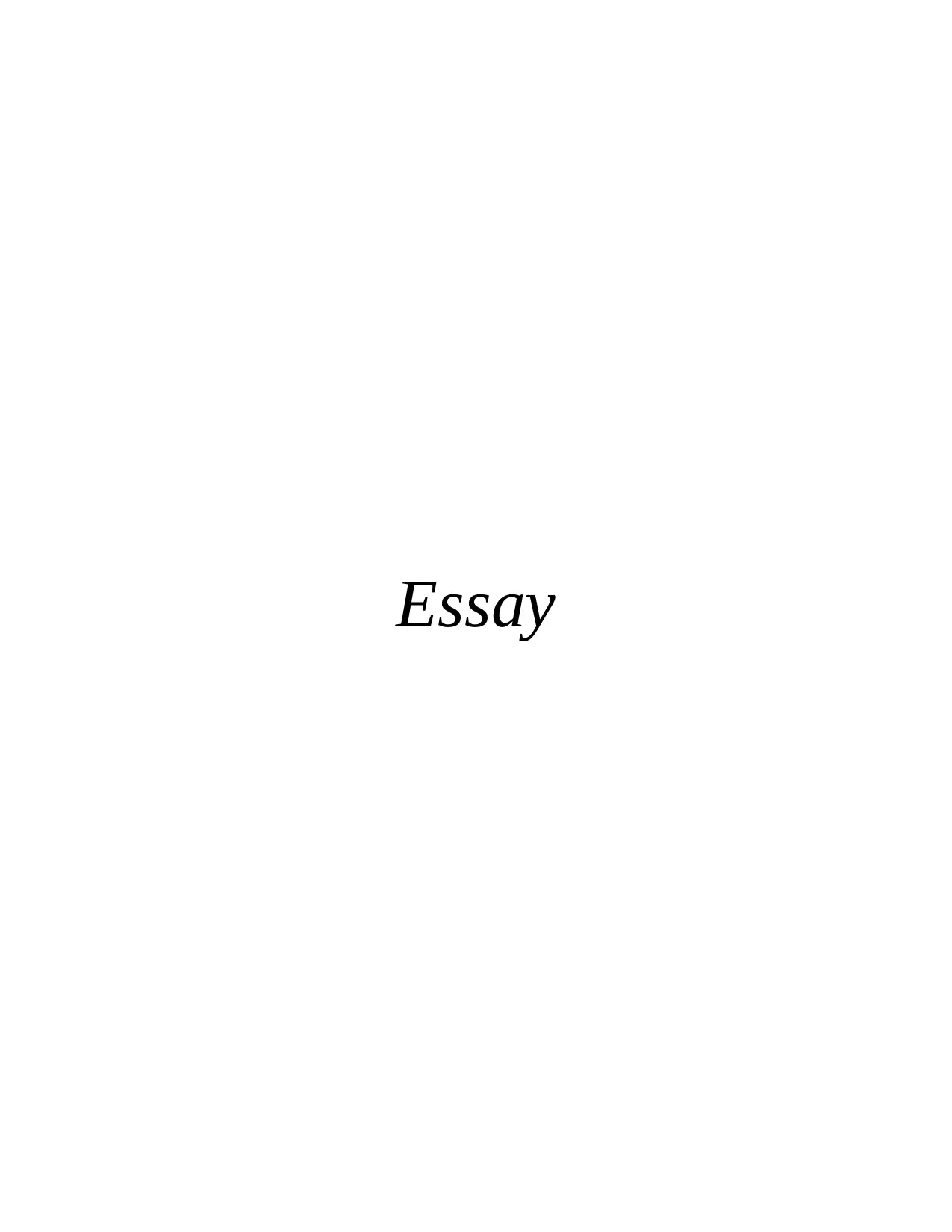
Essay
Paraphrase This Document
Need a fresh take? Get an instant paraphrase of this document with our AI Paraphraser

Contents
INTRODUCTION...........................................................................................................................1
MAIN BODY .................................................................................................................................1
CONCLUSION................................................................................................................................4
REFERENCES................................................................................................................................5
INTRODUCTION...........................................................................................................................1
MAIN BODY .................................................................................................................................1
CONCLUSION................................................................................................................................4
REFERENCES................................................................................................................................5
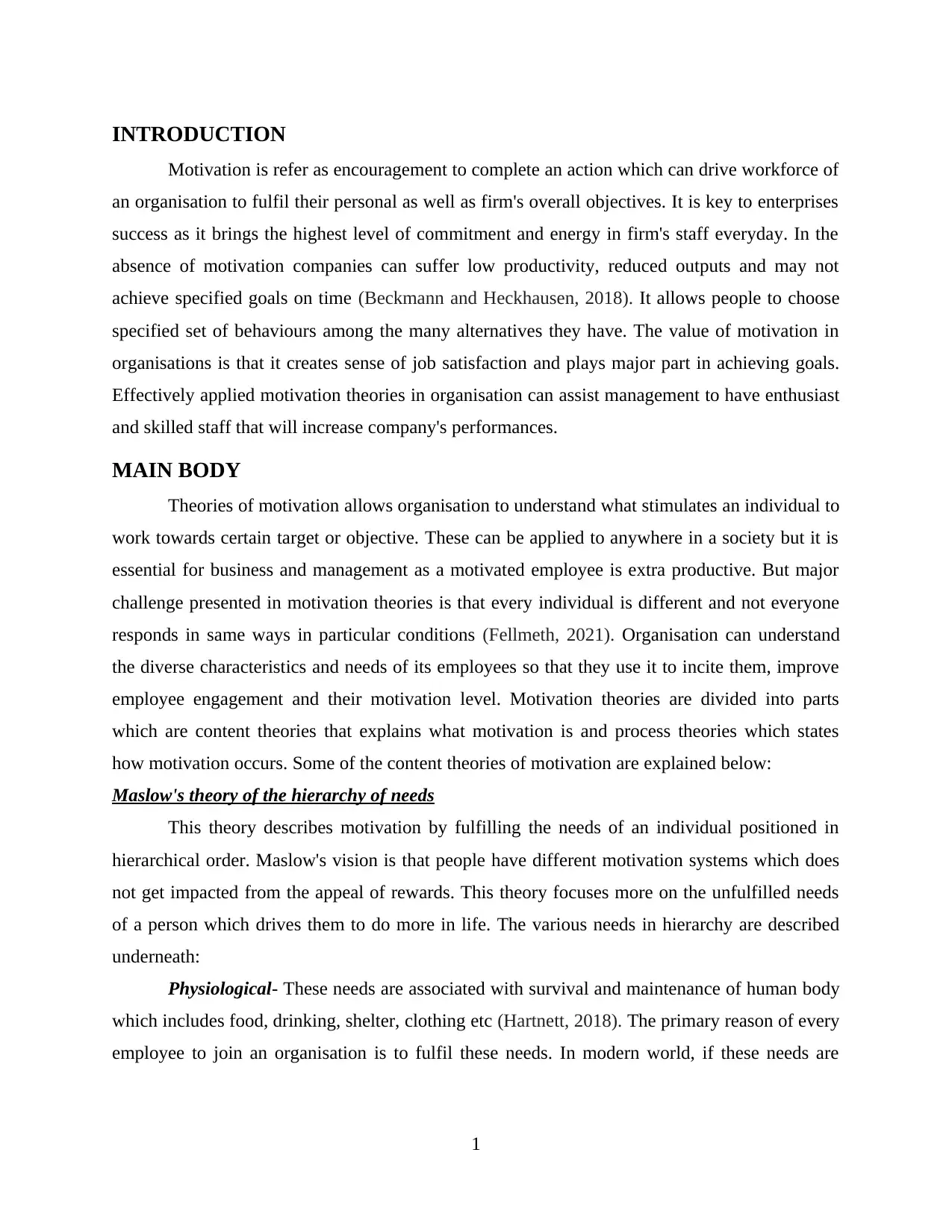
INTRODUCTION
Motivation is refer as encouragement to complete an action which can drive workforce of
an organisation to fulfil their personal as well as firm's overall objectives. It is key to enterprises
success as it brings the highest level of commitment and energy in firm's staff everyday. In the
absence of motivation companies can suffer low productivity, reduced outputs and may not
achieve specified goals on time (Beckmann and Heckhausen, 2018). It allows people to choose
specified set of behaviours among the many alternatives they have. The value of motivation in
organisations is that it creates sense of job satisfaction and plays major part in achieving goals.
Effectively applied motivation theories in organisation can assist management to have enthusiast
and skilled staff that will increase company's performances.
MAIN BODY
Theories of motivation allows organisation to understand what stimulates an individual to
work towards certain target or objective. These can be applied to anywhere in a society but it is
essential for business and management as a motivated employee is extra productive. But major
challenge presented in motivation theories is that every individual is different and not everyone
responds in same ways in particular conditions (Fellmeth, 2021). Organisation can understand
the diverse characteristics and needs of its employees so that they use it to incite them, improve
employee engagement and their motivation level. Motivation theories are divided into parts
which are content theories that explains what motivation is and process theories which states
how motivation occurs. Some of the content theories of motivation are explained below:
Maslow's theory of the hierarchy of needs
This theory describes motivation by fulfilling the needs of an individual positioned in
hierarchical order. Maslow's vision is that people have different motivation systems which does
not get impacted from the appeal of rewards. This theory focuses more on the unfulfilled needs
of a person which drives them to do more in life. The various needs in hierarchy are described
underneath:
Physiological- These needs are associated with survival and maintenance of human body
which includes food, drinking, shelter, clothing etc (Hartnett, 2018). The primary reason of every
employee to join an organisation is to fulfil these needs. In modern world, if these needs are
1
Motivation is refer as encouragement to complete an action which can drive workforce of
an organisation to fulfil their personal as well as firm's overall objectives. It is key to enterprises
success as it brings the highest level of commitment and energy in firm's staff everyday. In the
absence of motivation companies can suffer low productivity, reduced outputs and may not
achieve specified goals on time (Beckmann and Heckhausen, 2018). It allows people to choose
specified set of behaviours among the many alternatives they have. The value of motivation in
organisations is that it creates sense of job satisfaction and plays major part in achieving goals.
Effectively applied motivation theories in organisation can assist management to have enthusiast
and skilled staff that will increase company's performances.
MAIN BODY
Theories of motivation allows organisation to understand what stimulates an individual to
work towards certain target or objective. These can be applied to anywhere in a society but it is
essential for business and management as a motivated employee is extra productive. But major
challenge presented in motivation theories is that every individual is different and not everyone
responds in same ways in particular conditions (Fellmeth, 2021). Organisation can understand
the diverse characteristics and needs of its employees so that they use it to incite them, improve
employee engagement and their motivation level. Motivation theories are divided into parts
which are content theories that explains what motivation is and process theories which states
how motivation occurs. Some of the content theories of motivation are explained below:
Maslow's theory of the hierarchy of needs
This theory describes motivation by fulfilling the needs of an individual positioned in
hierarchical order. Maslow's vision is that people have different motivation systems which does
not get impacted from the appeal of rewards. This theory focuses more on the unfulfilled needs
of a person which drives them to do more in life. The various needs in hierarchy are described
underneath:
Physiological- These needs are associated with survival and maintenance of human body
which includes food, drinking, shelter, clothing etc (Hartnett, 2018). The primary reason of every
employee to join an organisation is to fulfil these needs. In modern world, if these needs are
1
⊘ This is a preview!⊘
Do you want full access?
Subscribe today to unlock all pages.

Trusted by 1+ million students worldwide
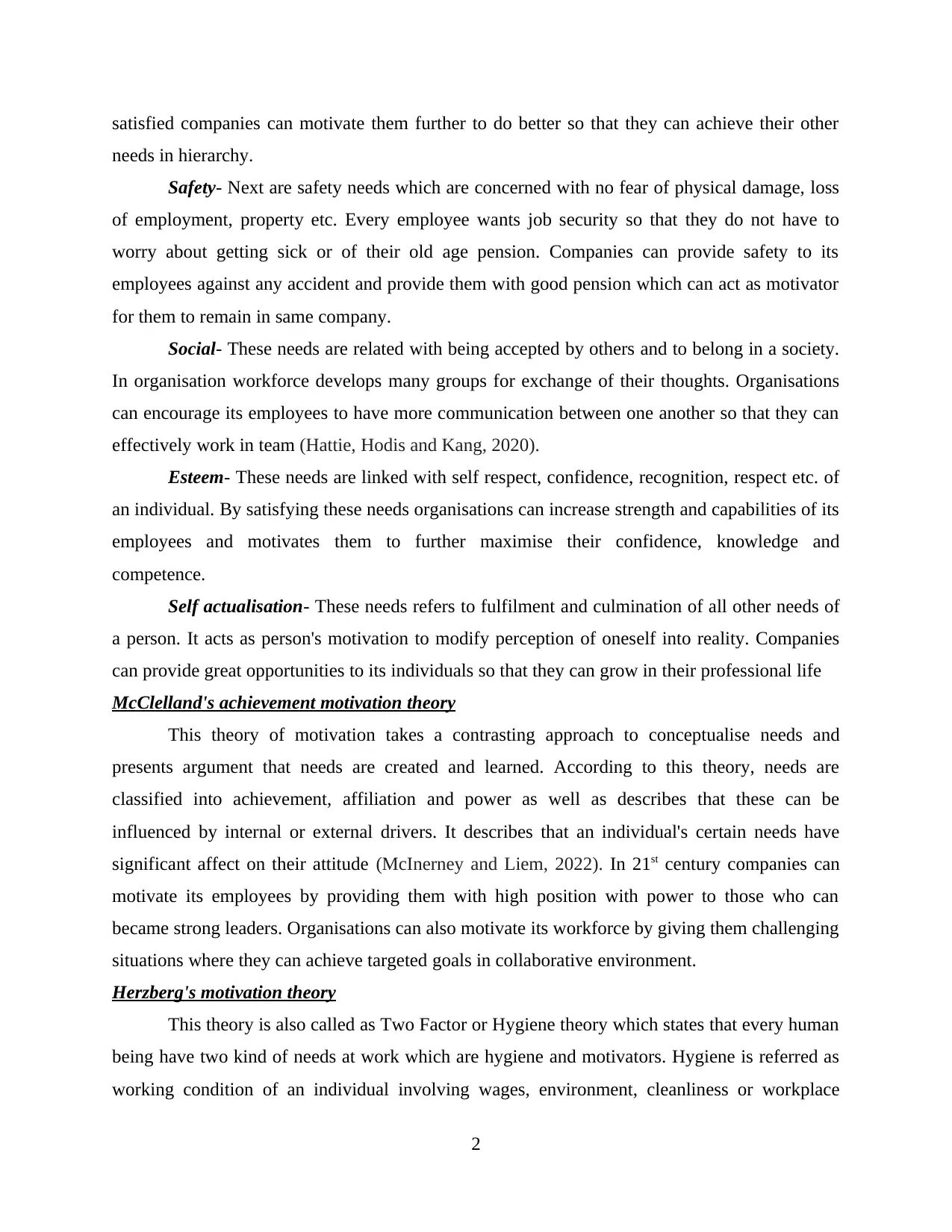
satisfied companies can motivate them further to do better so that they can achieve their other
needs in hierarchy.
Safety- Next are safety needs which are concerned with no fear of physical damage, loss
of employment, property etc. Every employee wants job security so that they do not have to
worry about getting sick or of their old age pension. Companies can provide safety to its
employees against any accident and provide them with good pension which can act as motivator
for them to remain in same company.
Social- These needs are related with being accepted by others and to belong in a society.
In organisation workforce develops many groups for exchange of their thoughts. Organisations
can encourage its employees to have more communication between one another so that they can
effectively work in team (Hattie, Hodis and Kang, 2020).
Esteem- These needs are linked with self respect, confidence, recognition, respect etc. of
an individual. By satisfying these needs organisations can increase strength and capabilities of its
employees and motivates them to further maximise their confidence, knowledge and
competence.
Self actualisation- These needs refers to fulfilment and culmination of all other needs of
a person. It acts as person's motivation to modify perception of oneself into reality. Companies
can provide great opportunities to its individuals so that they can grow in their professional life
McClelland's achievement motivation theory
This theory of motivation takes a contrasting approach to conceptualise needs and
presents argument that needs are created and learned. According to this theory, needs are
classified into achievement, affiliation and power as well as describes that these can be
influenced by internal or external drivers. It describes that an individual's certain needs have
significant affect on their attitude (McInerney and Liem, 2022). In 21st century companies can
motivate its employees by providing them with high position with power to those who can
became strong leaders. Organisations can also motivate its workforce by giving them challenging
situations where they can achieve targeted goals in collaborative environment.
Herzberg's motivation theory
This theory is also called as Two Factor or Hygiene theory which states that every human
being have two kind of needs at work which are hygiene and motivators. Hygiene is referred as
working condition of an individual involving wages, environment, cleanliness or workplace
2
needs in hierarchy.
Safety- Next are safety needs which are concerned with no fear of physical damage, loss
of employment, property etc. Every employee wants job security so that they do not have to
worry about getting sick or of their old age pension. Companies can provide safety to its
employees against any accident and provide them with good pension which can act as motivator
for them to remain in same company.
Social- These needs are related with being accepted by others and to belong in a society.
In organisation workforce develops many groups for exchange of their thoughts. Organisations
can encourage its employees to have more communication between one another so that they can
effectively work in team (Hattie, Hodis and Kang, 2020).
Esteem- These needs are linked with self respect, confidence, recognition, respect etc. of
an individual. By satisfying these needs organisations can increase strength and capabilities of its
employees and motivates them to further maximise their confidence, knowledge and
competence.
Self actualisation- These needs refers to fulfilment and culmination of all other needs of
a person. It acts as person's motivation to modify perception of oneself into reality. Companies
can provide great opportunities to its individuals so that they can grow in their professional life
McClelland's achievement motivation theory
This theory of motivation takes a contrasting approach to conceptualise needs and
presents argument that needs are created and learned. According to this theory, needs are
classified into achievement, affiliation and power as well as describes that these can be
influenced by internal or external drivers. It describes that an individual's certain needs have
significant affect on their attitude (McInerney and Liem, 2022). In 21st century companies can
motivate its employees by providing them with high position with power to those who can
became strong leaders. Organisations can also motivate its workforce by giving them challenging
situations where they can achieve targeted goals in collaborative environment.
Herzberg's motivation theory
This theory is also called as Two Factor or Hygiene theory which states that every human
being have two kind of needs at work which are hygiene and motivators. Hygiene is referred as
working condition of an individual involving wages, environment, cleanliness or workplace
2
Paraphrase This Document
Need a fresh take? Get an instant paraphrase of this document with our AI Paraphraser
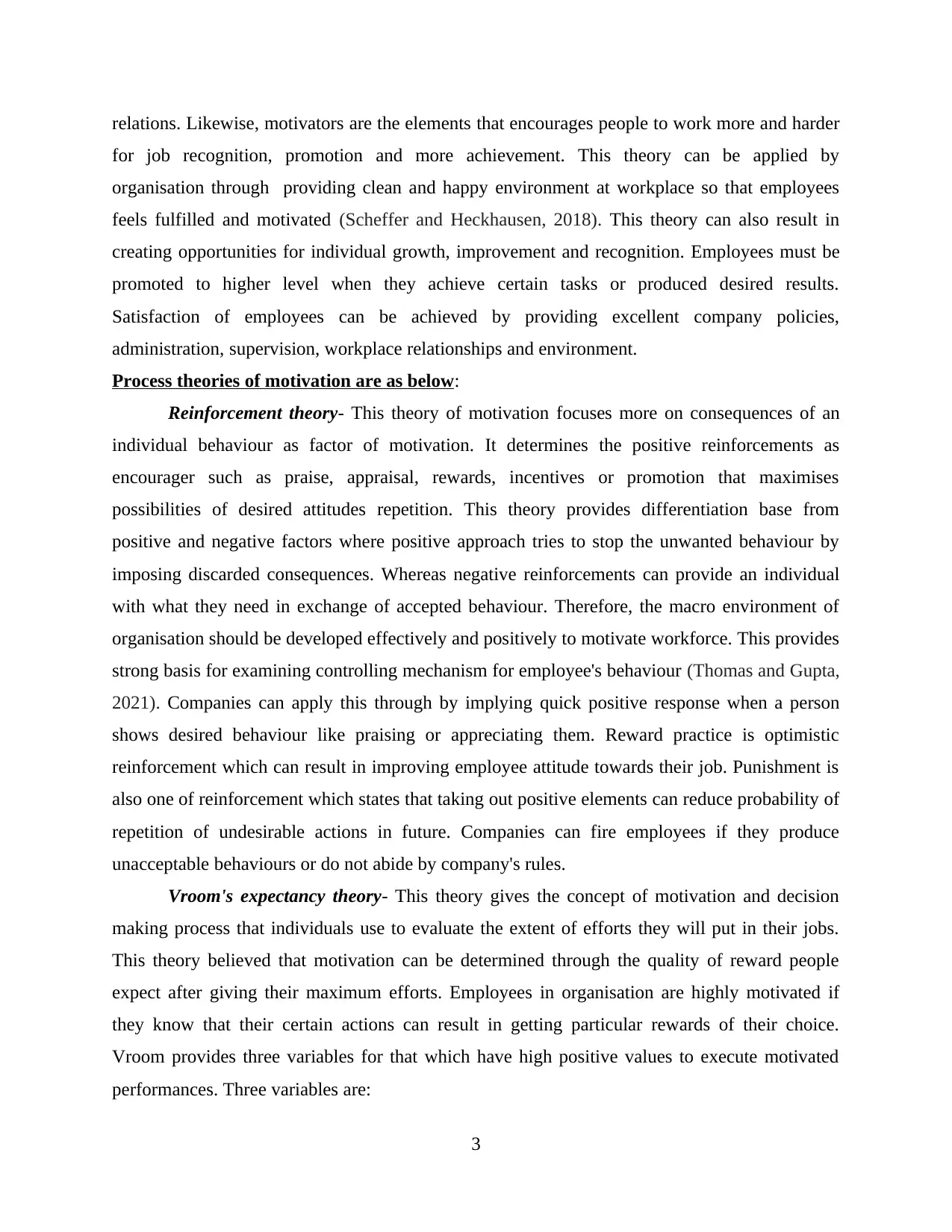
relations. Likewise, motivators are the elements that encourages people to work more and harder
for job recognition, promotion and more achievement. This theory can be applied by
organisation through providing clean and happy environment at workplace so that employees
feels fulfilled and motivated (Scheffer and Heckhausen, 2018). This theory can also result in
creating opportunities for individual growth, improvement and recognition. Employees must be
promoted to higher level when they achieve certain tasks or produced desired results.
Satisfaction of employees can be achieved by providing excellent company policies,
administration, supervision, workplace relationships and environment.
Process theories of motivation are as below:
Reinforcement theory- This theory of motivation focuses more on consequences of an
individual behaviour as factor of motivation. It determines the positive reinforcements as
encourager such as praise, appraisal, rewards, incentives or promotion that maximises
possibilities of desired attitudes repetition. This theory provides differentiation base from
positive and negative factors where positive approach tries to stop the unwanted behaviour by
imposing discarded consequences. Whereas negative reinforcements can provide an individual
with what they need in exchange of accepted behaviour. Therefore, the macro environment of
organisation should be developed effectively and positively to motivate workforce. This provides
strong basis for examining controlling mechanism for employee's behaviour (Thomas and Gupta,
2021). Companies can apply this through by implying quick positive response when a person
shows desired behaviour like praising or appreciating them. Reward practice is optimistic
reinforcement which can result in improving employee attitude towards their job. Punishment is
also one of reinforcement which states that taking out positive elements can reduce probability of
repetition of undesirable actions in future. Companies can fire employees if they produce
unacceptable behaviours or do not abide by company's rules.
Vroom's expectancy theory- This theory gives the concept of motivation and decision
making process that individuals use to evaluate the extent of efforts they will put in their jobs.
This theory believed that motivation can be determined through the quality of reward people
expect after giving their maximum efforts. Employees in organisation are highly motivated if
they know that their certain actions can result in getting particular rewards of their choice.
Vroom provides three variables for that which have high positive values to execute motivated
performances. Three variables are:
3
for job recognition, promotion and more achievement. This theory can be applied by
organisation through providing clean and happy environment at workplace so that employees
feels fulfilled and motivated (Scheffer and Heckhausen, 2018). This theory can also result in
creating opportunities for individual growth, improvement and recognition. Employees must be
promoted to higher level when they achieve certain tasks or produced desired results.
Satisfaction of employees can be achieved by providing excellent company policies,
administration, supervision, workplace relationships and environment.
Process theories of motivation are as below:
Reinforcement theory- This theory of motivation focuses more on consequences of an
individual behaviour as factor of motivation. It determines the positive reinforcements as
encourager such as praise, appraisal, rewards, incentives or promotion that maximises
possibilities of desired attitudes repetition. This theory provides differentiation base from
positive and negative factors where positive approach tries to stop the unwanted behaviour by
imposing discarded consequences. Whereas negative reinforcements can provide an individual
with what they need in exchange of accepted behaviour. Therefore, the macro environment of
organisation should be developed effectively and positively to motivate workforce. This provides
strong basis for examining controlling mechanism for employee's behaviour (Thomas and Gupta,
2021). Companies can apply this through by implying quick positive response when a person
shows desired behaviour like praising or appreciating them. Reward practice is optimistic
reinforcement which can result in improving employee attitude towards their job. Punishment is
also one of reinforcement which states that taking out positive elements can reduce probability of
repetition of undesirable actions in future. Companies can fire employees if they produce
unacceptable behaviours or do not abide by company's rules.
Vroom's expectancy theory- This theory gives the concept of motivation and decision
making process that individuals use to evaluate the extent of efforts they will put in their jobs.
This theory believed that motivation can be determined through the quality of reward people
expect after giving their maximum efforts. Employees in organisation are highly motivated if
they know that their certain actions can result in getting particular rewards of their choice.
Vroom provides three variables for that which have high positive values to execute motivated
performances. Three variables are:
3
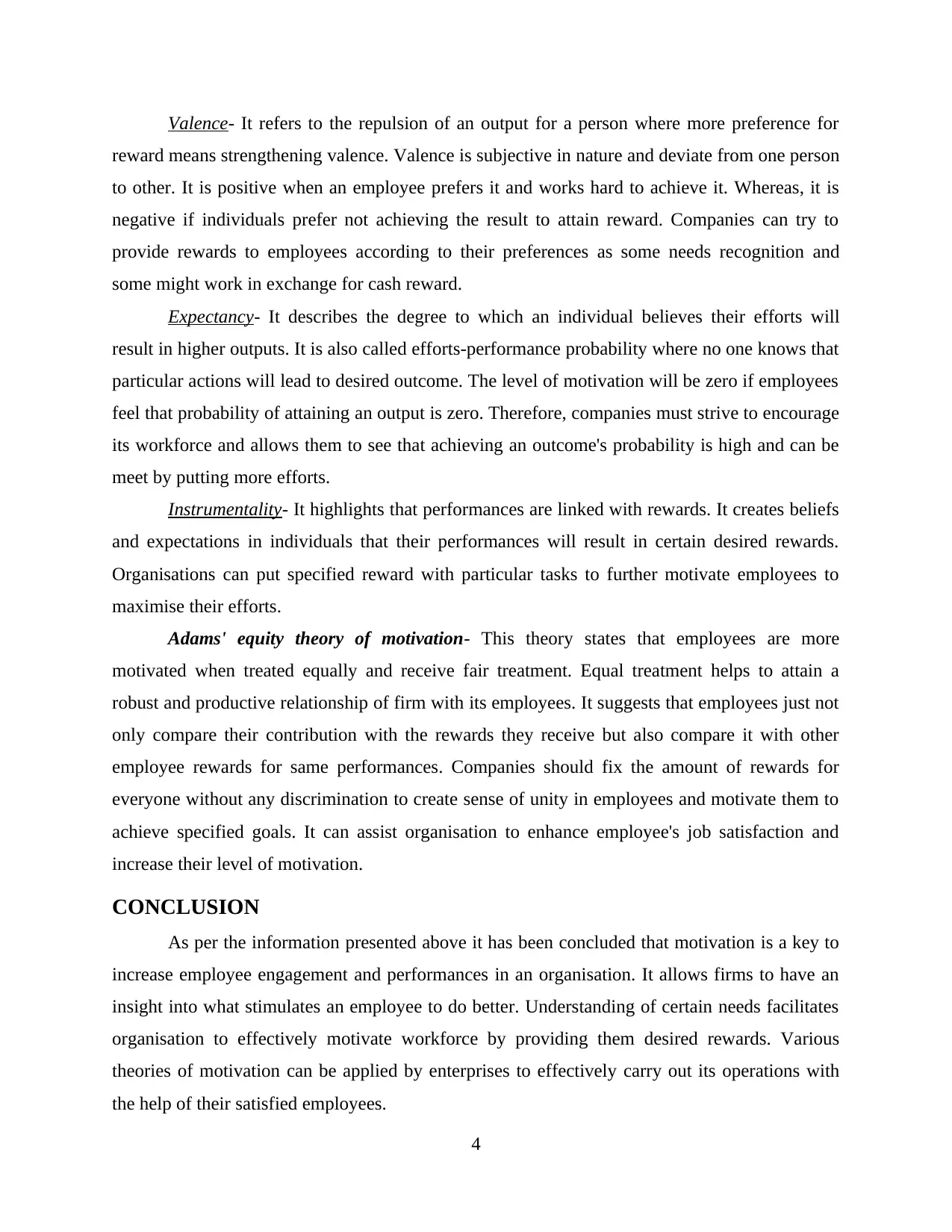
Valence- It refers to the repulsion of an output for a person where more preference for
reward means strengthening valence. Valence is subjective in nature and deviate from one person
to other. It is positive when an employee prefers it and works hard to achieve it. Whereas, it is
negative if individuals prefer not achieving the result to attain reward. Companies can try to
provide rewards to employees according to their preferences as some needs recognition and
some might work in exchange for cash reward.
Expectancy- It describes the degree to which an individual believes their efforts will
result in higher outputs. It is also called efforts-performance probability where no one knows that
particular actions will lead to desired outcome. The level of motivation will be zero if employees
feel that probability of attaining an output is zero. Therefore, companies must strive to encourage
its workforce and allows them to see that achieving an outcome's probability is high and can be
meet by putting more efforts.
Instrumentality- It highlights that performances are linked with rewards. It creates beliefs
and expectations in individuals that their performances will result in certain desired rewards.
Organisations can put specified reward with particular tasks to further motivate employees to
maximise their efforts.
Adams' equity theory of motivation- This theory states that employees are more
motivated when treated equally and receive fair treatment. Equal treatment helps to attain a
robust and productive relationship of firm with its employees. It suggests that employees just not
only compare their contribution with the rewards they receive but also compare it with other
employee rewards for same performances. Companies should fix the amount of rewards for
everyone without any discrimination to create sense of unity in employees and motivate them to
achieve specified goals. It can assist organisation to enhance employee's job satisfaction and
increase their level of motivation.
CONCLUSION
As per the information presented above it has been concluded that motivation is a key to
increase employee engagement and performances in an organisation. It allows firms to have an
insight into what stimulates an employee to do better. Understanding of certain needs facilitates
organisation to effectively motivate workforce by providing them desired rewards. Various
theories of motivation can be applied by enterprises to effectively carry out its operations with
the help of their satisfied employees.
4
reward means strengthening valence. Valence is subjective in nature and deviate from one person
to other. It is positive when an employee prefers it and works hard to achieve it. Whereas, it is
negative if individuals prefer not achieving the result to attain reward. Companies can try to
provide rewards to employees according to their preferences as some needs recognition and
some might work in exchange for cash reward.
Expectancy- It describes the degree to which an individual believes their efforts will
result in higher outputs. It is also called efforts-performance probability where no one knows that
particular actions will lead to desired outcome. The level of motivation will be zero if employees
feel that probability of attaining an output is zero. Therefore, companies must strive to encourage
its workforce and allows them to see that achieving an outcome's probability is high and can be
meet by putting more efforts.
Instrumentality- It highlights that performances are linked with rewards. It creates beliefs
and expectations in individuals that their performances will result in certain desired rewards.
Organisations can put specified reward with particular tasks to further motivate employees to
maximise their efforts.
Adams' equity theory of motivation- This theory states that employees are more
motivated when treated equally and receive fair treatment. Equal treatment helps to attain a
robust and productive relationship of firm with its employees. It suggests that employees just not
only compare their contribution with the rewards they receive but also compare it with other
employee rewards for same performances. Companies should fix the amount of rewards for
everyone without any discrimination to create sense of unity in employees and motivate them to
achieve specified goals. It can assist organisation to enhance employee's job satisfaction and
increase their level of motivation.
CONCLUSION
As per the information presented above it has been concluded that motivation is a key to
increase employee engagement and performances in an organisation. It allows firms to have an
insight into what stimulates an employee to do better. Understanding of certain needs facilitates
organisation to effectively motivate workforce by providing them desired rewards. Various
theories of motivation can be applied by enterprises to effectively carry out its operations with
the help of their satisfied employees.
4
⊘ This is a preview!⊘
Do you want full access?
Subscribe today to unlock all pages.

Trusted by 1+ million students worldwide
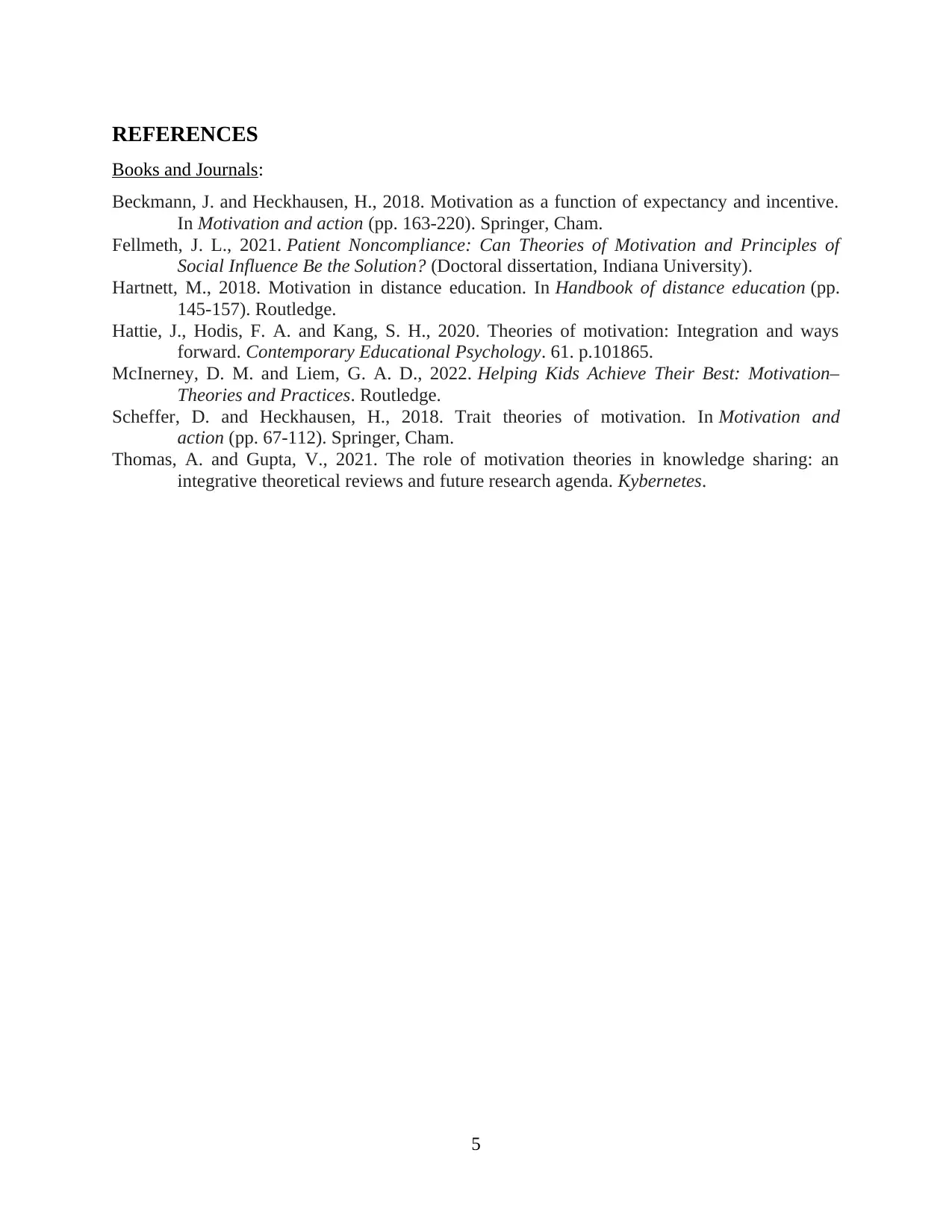
REFERENCES
Books and Journals:
Beckmann, J. and Heckhausen, H., 2018. Motivation as a function of expectancy and incentive.
In Motivation and action (pp. 163-220). Springer, Cham.
Fellmeth, J. L., 2021. Patient Noncompliance: Can Theories of Motivation and Principles of
Social Influence Be the Solution? (Doctoral dissertation, Indiana University).
Hartnett, M., 2018. Motivation in distance education. In Handbook of distance education (pp.
145-157). Routledge.
Hattie, J., Hodis, F. A. and Kang, S. H., 2020. Theories of motivation: Integration and ways
forward. Contemporary Educational Psychology. 61. p.101865.
McInerney, D. M. and Liem, G. A. D., 2022. Helping Kids Achieve Their Best: Motivation–
Theories and Practices. Routledge.
Scheffer, D. and Heckhausen, H., 2018. Trait theories of motivation. In Motivation and
action (pp. 67-112). Springer, Cham.
Thomas, A. and Gupta, V., 2021. The role of motivation theories in knowledge sharing: an
integrative theoretical reviews and future research agenda. Kybernetes.
5
Books and Journals:
Beckmann, J. and Heckhausen, H., 2018. Motivation as a function of expectancy and incentive.
In Motivation and action (pp. 163-220). Springer, Cham.
Fellmeth, J. L., 2021. Patient Noncompliance: Can Theories of Motivation and Principles of
Social Influence Be the Solution? (Doctoral dissertation, Indiana University).
Hartnett, M., 2018. Motivation in distance education. In Handbook of distance education (pp.
145-157). Routledge.
Hattie, J., Hodis, F. A. and Kang, S. H., 2020. Theories of motivation: Integration and ways
forward. Contemporary Educational Psychology. 61. p.101865.
McInerney, D. M. and Liem, G. A. D., 2022. Helping Kids Achieve Their Best: Motivation–
Theories and Practices. Routledge.
Scheffer, D. and Heckhausen, H., 2018. Trait theories of motivation. In Motivation and
action (pp. 67-112). Springer, Cham.
Thomas, A. and Gupta, V., 2021. The role of motivation theories in knowledge sharing: an
integrative theoretical reviews and future research agenda. Kybernetes.
5
1 out of 7
Related Documents
Your All-in-One AI-Powered Toolkit for Academic Success.
+13062052269
info@desklib.com
Available 24*7 on WhatsApp / Email
![[object Object]](/_next/static/media/star-bottom.7253800d.svg)
Unlock your academic potential
Copyright © 2020–2025 A2Z Services. All Rights Reserved. Developed and managed by ZUCOL.





